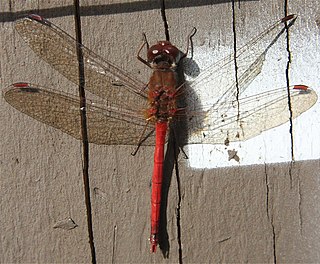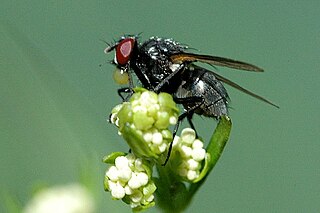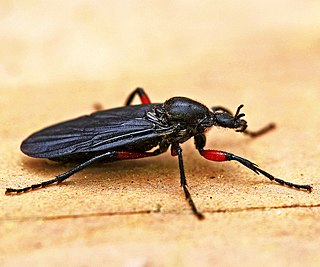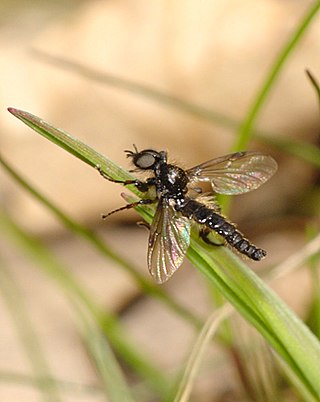
Horse-flies and deer flies are true flies in the family Tabanidae in the insect order Diptera. The adults are often large and agile in flight. Only female horseflies bite land vertebrates, including humans, to obtain blood. They prefer to fly in sunlight, avoiding dark and shady areas, and are inactive at night. They are found all over the world except for some islands and the polar regions. Both horse-flies and botflies (Oestridae) are sometimes referred to as gadflies.

The yellow-footed rock-wallaby, formerly known as the ring-tailed rock-wallaby, is a member of the macropod family.

Bibionidae is a family of flies (Diptera) containing approximately 650–700 species worldwide. Adults are nectar feeders and emerge in numbers in spring. Because of the likelihood of adult flies being found in copula, they have earned colloquial names such as "love bugs" or "honeymoon flies".
Buckaringa Sanctuary is a 20 km2 nature reserve in the southern Flinders Ranges of South Australia. It is 30 km north of the town of Quorn. It is owned and managed by the Australian Wildlife Conservancy (AWC).

Sympetrum vicinum, the Yellow-Legged Meadowhawk is one of some fifteen North American species of autumn meadowhawk, which are members of the Odonate family Libellulidae. It grows to 26–35 mm long.

Hydrotaea is a genus of insects in the housefly family, Muscidae. They occur in most regions of the world but are more populous in warmer climates. They are often found on feces in summer months, and are therefore generally found in close proximity to livestock. Among the 130 known species in this genus, one of the most commonly recognized is the dump fly.

Bibio marci or St. Mark's fly or hawthorn fly, is a species of fly from the family Bibionidae. It is found across much of Europe. Their common name comes from the fact that the adults usually emerge around St Mark's Day, 25 April.

Bibio, March flies or St. Mark's flies, is a genus of flies (Diptera).

Bibio femoratus, also known as the March fly or lovebug, is a species of fly in the family Bibionidae. It was first described by the German entomologist Christian Rudolph Wilhelm Wiedemann in 1820.Bibio femoratus is one of at least 90 types of March flies, which occur in the United States and Canada.

Trichopoda pennipes is a species of feather-legged fly in the dipteran family Tachinidae.

Bibio pomonae, common name red-thighed St Mark's fly or heather fly, is a species of fly (Diptera) belonging to the family Bibionidae.

Bibio varipes is a species of fly in the family Bibionidae. It is found in the Palearctic.

Bibio lanigerus is a species of fly in the family Bibionidae. It is found in the Palearctic.

Bibio hortulanus, common name marchfly, is a species of fly from the family Bibionidae.
Bibio venosus is a species of fly in the family Bibionidae. It is found in the Palearctic.
Bibio rufithorax is a species of March fly in the family Bibionidae.

Bibio articulatus, or the red-legged March fly, is a species of March fly in the family Bibionidae. Its distinctive features are its dark exoskeleton that varries from black to a deep red, and red/orange legs leading to its common name being "red-legged March fly."

Dilophus nigrostigma is a species of Bibionidae fly endemic to New Zealand. It is the largest and most common species of Dilophus in New Zealand.

Bibio imitator, common name garden maggot, is a species of fly from the genus Bibio, first described by Francis Walker in The Entomological Magazine vol 2, 1835. It occurs in Australia and New Zealand.

Bibio albipennis is a species of March fly. It native to North America, where it is widespread.
















